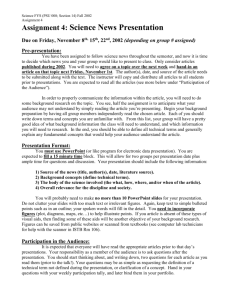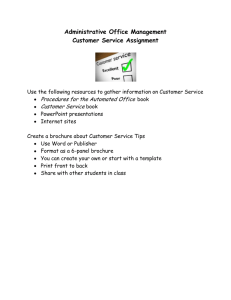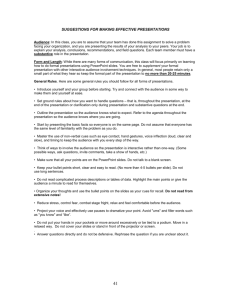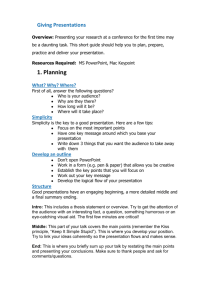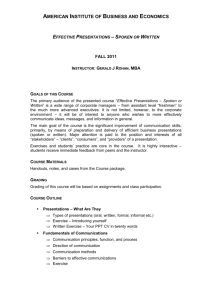PRESENTATIONS English STUDY GUIDE
advertisement
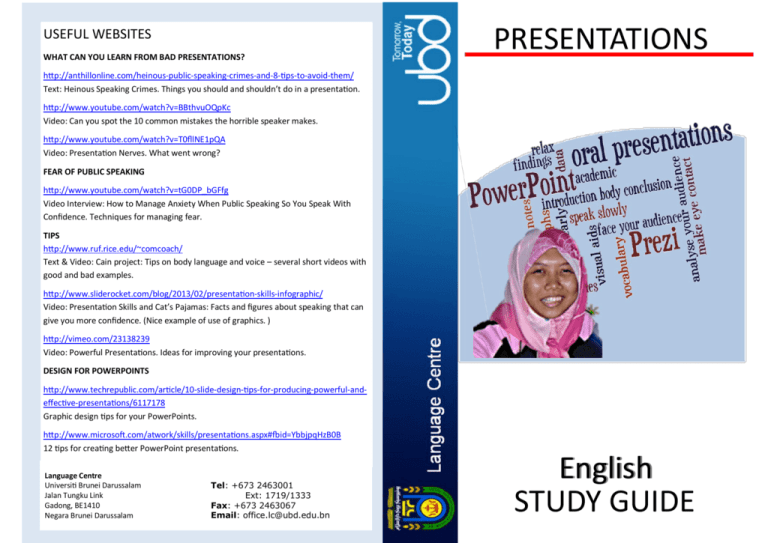
USEFUL WEBSITES WHAT CAN YOU LEARN FROM BAD PRESENTATIONS? PRESENTATIONS http://anthillonline.com/heinous-public-speaking-crimes-and-8-tips-to-avoid-them/ Text: Heinous Speaking Crimes. Things you should and shouldn’t do in a presentation. http://www.youtube.com/watch?v=BBthvuOQpKc Video: Can you spot the 10 common mistakes the horrible speaker makes. http://www.youtube.com/watch?v=T0fllNE1pQA Video: Presentation Nerves. What went wrong? FEAR OF PUBLIC SPEAKING http://www.youtube.com/watch?v=tG0DP_bGFfg Video Interview: How to Manage Anxiety When Public Speaking So You Speak With Confidence. Techniques for managing fear. TIPS http://www.ruf.rice.edu/~comcoach/ Text & Video: Cain project: Tips on body language and voice – several short videos with good and bad examples. http://www.sliderocket.com/blog/2013/02/presentation-skills-infographic/ Video: Presentation Skills and Cat’s Pajamas: Facts and figures about speaking that can give you more confidence. (Nice example of use of graphics. ) http://vimeo.com/23138239 Video: Powerful Presentations. Ideas for improving your presentations. DESIGN FOR POWERPOINTS http://www.techrepublic.com/article/10-slide-design-tips-for-producing-powerful-andeffective-presentations/6117178 Graphic design tips for your PowerPoints. http://www.microsoft.com/atwork/skills/presentations.aspx#fbid=YbbjpqHzB0B 12 tips for creating better PowerPoint presentations. Language Centre Universiti Brunei Darussalam Jalan Tungku Link Gadong, BE1410 Negara Brunei Darussalam Tel: +673 2463001 Ext: 1719/1333 Fax: +673 2463067 Email: office.lc@ubd.edu.bn English STUDY GUIDE GUIDE TO PREPARING AN ORAL PRESENTATION There are 5 recommended steps to follow in preparing an oral presentation. 1. Analysing your audience 2. Choosing and narrowing your topic 3. Gathering information 4. Preparing visual aids 5. Organizing your speech 1 Analysing your audience Knowing who your audience is will help you prepare a speech that is relevant and interesting to your listeners. For example, you would not use very scientific language to explain the digestive system to a group of Year One students. These questions might help you in analysing your audience in preparation for your presentation: 2 Who is your audience? Why will the presentation be relevant to them? How can you attract their interest? Choosing & Narrowing your Topic A quick and easy way to find a good topic is to choose a topic that you know a lot about or that is of interest to you. If the topic has already been given well before hand, you need to narrow down the topic for the presentation; only select information that is relevant to your findings and will interest your audience. You may want to consider these 3 points in narrowing information effectively: Make the information specific Focus on ONE main idea Make sure the audience is able to understand and remember the information after your presentation. 3 Gathering Information A good way to begin is to write down what you already know about your topic. Once you have done this, you need to research relevant information from reliable sources to support your opinion. Once you have the necessary information needed to support your opinion, you now need to organize your materials. For the structure of your presentation, you will need: An introduction of your topic Your methodology (description of procedure used) Findings (including graphs, etc.) Conclusion based on your findings Recommendations derived from your conclusion 4 Preparing your visual aids (PowerPoint slides) Visual aids such as pictures and graphs can make your speech more interesting and can be a very powerful tool. However, there are certain factors that can also affect the attention of your audience. Do not use too many words in a slide – this can become completely distracting and your audience will not be able to read them all. Note form is far more effective as your audience can fully concentrate on what you have to say instead of reading the slides. Make sure the font size used is an appropriate size. Avoid irritating transitions on your PowerPoint – this can distract your audience & interrupt the smoothness in the flow of your presentation Avoid unnecessary sound effects. 5 Organising your speech A good speech includes the following: 1. Introduction [not on your topic but what you will present] Within the introduction, you need to: Engage your listeners State your purpose Present an outline of your presentation 2. The Body Here, you will start presenting your initial research: An introduction of your topic Methodology Findings (including graphs) Conclusion based on your findings Recommendations derived from your conclusion 3. The Conclusion The conclusion here means that you are to leave your audience with a clear summary of your topic and that you do not abruptly end your presentation – you need to make it obvious that you have reached the end . REMINDER DO NOT READ WHOLE PARAGRAPHS If you need notes, do make sure that you write them in note form, not whole paragraphs as you will tend to read off them. FACE YOUR AUDIENCE You do not want to be presenting to the wall or to the floor. MAINTAIN EYE CONTACT This will help your audience feel that you are Interacting with them and it can also attract their interest to your presentation. SPEAK SLOWLY & CLEARLY You want your audience to understand what you have to present. If they are unable to hear or understand you they will lose interest .
